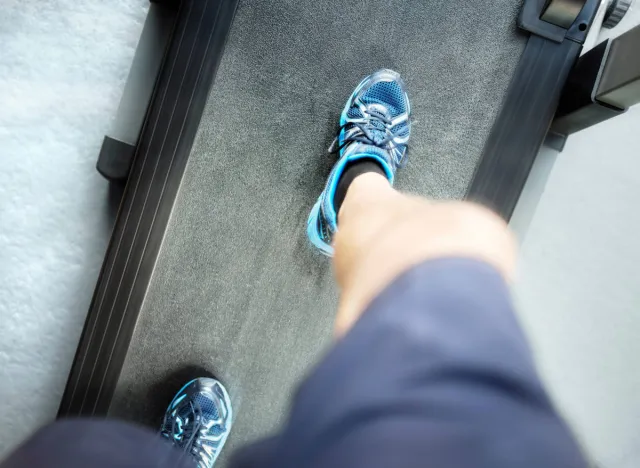Treadmill walking is a seamless way to stay active. No matter the time of year or what the weather’s doing, you can lace up your sneakers, hop on the treadmill, and get your steps in. However, there are still some essential rules to using the treadmill properly. We spoke with a fitness pro who breaks down eight common mistakes to avoid when treadmill walking so you can get the most out of every cardio session.
Walking on a treadmill is an excellent way to boost your endurance and cardiovascular fitness. It’s also a great tool for burning calories and achieving your weight-loss goals. That being said, making certain common mistakes can create unwelcome setbacks and even result in injury. It all comes down to using proper form.
“Poor form can lead to injury,” stresses Ellen Thompson, CPT, Blink Fitness. “Proper alignment reduces stress on joints and muscles and, therefore, decreases the risk of injury. Proper form improves breathing; standing upright allows for better lung expansion and ensures you [get] enough oxygen during your workout.”
In addition, maintaining proper form and posture activates the muscles in your core, which, in turn, prevents slouching. This also helps improve stability and balance, further reducing your injury risk.
Now, let’s dive into the most common mistakes to avoid when treadmill walking and why they’re major no-nos, according to Thompson.
Holding onto the handrails

Holding onto the treadmill handrails may seem like a smart way to establish better stability and balance; however, it can ruin your cardio session.
“Holding onto [the] handrails reduces the effectiveness of your workout because it decreases the natural engagement of your muscles (specifically your core and legs), Thompson explains. “It adds an outside factor that isn’t necessarily helpful.”
Not using a natural arm swing


Another common error that’s deterring your progress is not using a natural arm swing. By keeping your arms at your sides, you’re not engaging your upper body and turning your treadmill time into a total-body workout.
“[In addition,] failing to move your arms naturally can throw off your balance and decrease the effectiveness of your workout,” says Thompson. “Use your arms for a natural swing. This will keep your walking motion smooth and allow you to maintain proper balance.”
Overstriding


Overstriding means taking steps that are too big. This can lead to injury or place undue strain on your hips, knees, and lower back. “[Overstriding] also disrupts your natural walking pattern, which can lead to shin splints and other potential injuries,” Thompson points out.
Walking too fast or too slow


Being mindful of your walking pace is essential. “Walking too fast can cause you to lose control, leading to falls or muscle strains,” Thompson says. “Walking too slow might not give you the benefits you aim for.” For instance, walking at a very slow pace may not present enough of a challenge for your cardiovascular system, resulting in far fewer calories burned.
“Don’t walk too fast, too slow, too long, or too short,” Thompson encourages. “A natural stride is the most comfortable and will lead to the most effective workout.”
Leaning forward


Leaning too far forward when walking on a treadmill can disrupt your posture and result in discomfort or injury. “This goes against proper form and can put unnecessary strain on the lower back,” Thompson explains.
Make it your goal to stand tall while keeping your shoulders back and your abs activated. Maintaining an upright posture is the name of the game, as it helps decrease strain on your body and gives you an all-around more productive treadmill session.
Not making use of the incline settings


You’re doing yourself a major disservice by not utilizing the treadmill incline settings. “Walking on a flat surface doesn’t challenge your muscles or as much as walking on an incline does,” Thompson explains.
Incorporating inclines into your workout engages more muscle groups and adds an invigorating intensity that helps you progress. It’s an excellent way to take your workout to the next level without needing to adjust the speed very much.
Looking down


It may be a natural reaction to look down at your feet when treadmill walking, but try to avoid this. When looking down, you may assume a hunched posture, which can strain your neck. “It also throws off your balance, making you more prone to misstepping,” Thompson adds.
Wearing the wrong footwear


Being equipped with the proper footwear is essential to walking success. “Proper footwear is key! Shoes that don’t provide proper support or cushioning can lead to injury, blisters, and other foot-related injuries,” Thompson explains.
The right walking shoes should be supportive, breathable, durable, and the perfect fit.














Leave a Reply